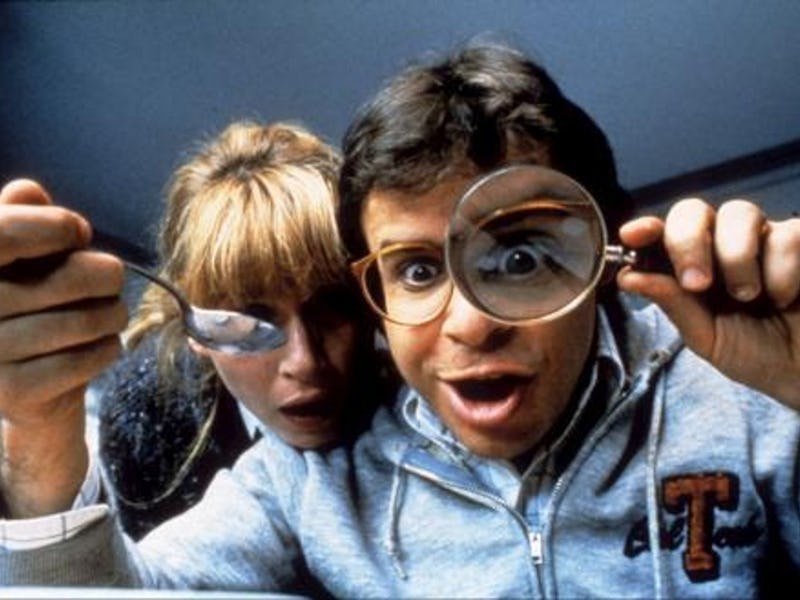A Cinematic History of Ant-Men
Severe shrinkage is one of Hollywood's most popular and strangest tropes. What does it mean?

Shrinking characters is one of the least understood and most compact tropes in movie history. It’s a high concept plot device that goes against the natural order, fighting not only the American inclination to grow, but also the nature of projection itself, which inflates stars into giants. The paradox here is that movies featuring small characters show the world at that scale, highlighting the remarkable intricacy and complexity of, well, everything. Smallness complicates, but it also does the opposite by forcing characters to focus in on their very, very specific objectives.
With Ant-Man, featuring one of the least understood and most compact characters in the Marvel Universe, making its big-screen debut, now seems an appropriate time to make sense of a the tiny trend writ large. Here are the movies that taught us to get small.
5. Willy Wonka & the Chocolate Factory
The original 1971 adaptation of Roald Dahl’s novel Charlie and the Chocolate Factory — rightfully changed to Willy Wonka and the Chocolate Factory since Gene Wilder is the focal point — doesn’t completely focus on a character shrinking in size. Instead, as Wilder’s job creator leads the lucky golden ticket winners through each surreal nook and cranny of his chocolate factory, one character, Television-obsessed American brat Mike Teavee, is shrunken by Wonka’s Wonkavision. His shrinking causes him to teleported into a nearby television, making him and his big mouth mere millimeters tall. It’s divine justice, but also a meta-commentary on television as a medium. In the days before giants plasmas, it made people smaller. It was the original shrinking machine.
4. Fantastic Voyage
This is the grandaddy of all shrinking movies, and it arrived during the halcyon days of big budget sci-fi schlock. The movie is about a group of scientists that shrink down to microscopic size and are sent with top secret information into the body of a Soviet defector to destroy a blood clot that threatens to kill him. This Red Scare sci-fi extravaganza came along as the Space Race was at its peak, so it has scientific determinism to it despite the terrible (laser-based) science at the heart of the plot. In retrospect, the effects are cheesy as hell, but please don’t belittle them: They were state of the art.
If Fantastic Voyage is a silly movie — and it is — it’s also smart in a very particular way. So much of the Cold War was international, three-dimensional chess, that it was easy to forget the significance of one man and one blood clot. The movie is a stark reminder that the fate of our world often depends on the tiniest things in it.
3. Alice in Wonderland
This is the second big screen adaptation on this list to later be remade by Tim Burton. Alice in Wonderland perhaps typifies the core idea behind what the shrinking metaphor means. To get to Wonderland, a place that represents her hopes, fears, and desires, Alice willfully shrinks herself and makes herself vulnerable. Later, once she stands up to authority by insulting the ruthless Queen of Hearts and learns to believe in herself, she turns back to normal and wakes up from her dream. Lessons learned, adventures had — and all because of the shrinkage.
2. Innerspace
Innerspace is a bit of a cheat because the film is legendary genre director Joe Dante’s ‘80s update of Fantastic Voyage. The details may be different, but the micro-medical-mission premise, Cold War paranoia, and pre-digital special effects are basically the same. Instead of coming to the aid of an ailing Russian defector, the now lone mini-scientist and former Navy pilot, played by Dennis Quaid, is shrunken down and prepared to be injected into a rabbit, but, when a rival group attacks the lab, Quaid’s character finds himself injected into a high-strung grocery store worker named Jack (Martin Short). The sci-fi zaniness rolls on from there as Jack must team up with Quaid’s estranged girlfriend (Meg Ryan) to stop the rival group. By the end of the movie, you have nothing but the size switch to thank when Quaid and Ryan’s characters get hitched and Martin Short’s character learns some self respect. He just had to listen to the voice inside of himself.
1. Honey, I Shrunk the Kids
The ultimate example of a family coming together through the power of shrinking… at least until Honey, We Shrunk Ourselves came out in 1997. The tale of harebrained scientist Wayne Szalinski (Rick Moranis) inadvertently shrinking his kids to the size of insects with a homemade shrinking machine was a 1990s VCR staple. It remains the single best movie with the size-changing premise out there because of the way it plays off its premise. Rather than being a movie about being small, it is a movie about problems seeming big and one family’s fight to overcome them.
And that’s perhaps the idea that so many of these movies share, that the world is an immensely massive place, but it remains conquerable if you take one tiny step at a time.